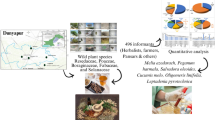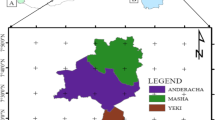Abstract
The use of complementary and alternative medicine (CAM) by US consumers has grown in recent years. CAM therapies often utilize medicinal herbs as part of the treatment process; however, research on US practitioner preferences for medicinal herbs is limited, despite growing concern surrounding the sustainability of wild-harvested medicinal herbs. In order better to understand consumer preferences for this emerging market, a mail survey of US practitioners (licensed acupuncturists) was conducted to examine the importance of five herb attributes in practitioners’ herb selection decisions: (1) country of origin, (2) freshness, (3) production method (organic versus conventional), (4) price, and (5) traceability. The significance of these five traits is investigated using discrete choice analysis, and the implications for US medicinal herb growers are discussed.


Similar content being viewed by others
Notes
For example, in 2000 the Medicinal Herb Consortium was created. This consortium consisted of grower associations across five states: CA, MN, NY, NM, and WV (Giblette and Martin 2007).
Retailers in the food industry are often referred to as “channel captains” as they are instrumental in making market decisions regarding key product attributes (e.g., quality) for the entire food chain (Kohls and Uhl 2002). Due to the complex nature of medical herb formulations and the practitioner-patient relationship, Chinese medicinal herb practitioners play the same important role in the Chinese medicinal herb market.
Often herbal prescriptions are formulated from a large number of individual herbs. For this reason, practitioners, rather than patients, make the majority of decisions regarding the specific attributes of herbs to be prescribed, and for the purposes of this study we consider practitioners the primary source of demand.
The American Association of Acupuncture and Oriental Medicine uses the term “Oriental” rather than “Chinese” medicine.
Master’s programs accredited by the ACAOM are recognized by the US Department of Education. At the time of writing, however, the doctoral programs accredited by the ACAOM are not yet recognized by the US Department of Education (ACAOM 2010).
Giblette and Martin (2007) conducted a feasibility study, but product pricing was not considered.
Contact information for survey respondents was purchased from the mailing list of a trade journal for licensed acupuncturists. Approximately 3–5 contacts were blind tests for the purchasing company, resulting in a net sample of 1,995 surveys.
The low response rate may be due, in part, to the particular sampling frame used in the study. As indicated earlier, a majority of acupuncturists sell products (often herb products) to their patients. While acupuncturists may sell herbs to their patients, the amount of sales may vary and may be considered by some practitioners as a small part of their core business; thus some survey recipients may have chosen not to respond to the survey.
Survey participants were presented with an unspecified “basket of Chinese medicinal herbs” that were identical in makeup except for the attributes described in each choice description. Another approach that could have been utilized would have specified a particular herb. The first approach was selected in preference to the second due to the large number of herbs used within the industry. If a particular herb been specified in the choices presented to the participants, some participants may have hesitated to answer the question (e.g., if they did not use the specified herb on a frequent basis).
Unique choices in each choice set would result in 96 unique choices. The difference between maximum unique choices and actual unique choices were a result of duplicate choices across different choice sets (i.e., survey versions).
Related to both individual-specific and alternative-specific attributes.
Specification requires the assumption that errors (ε) are distributed independent and identically (iid) according to the extreme value type I distribution (sometimes referred to as the Weibull, Gumbel, and double-exponential distribution (Louviere et al. 2000).
Sample sizes for descriptive statistics vary as some survey respondents declined to answer certain demographic questions.
References
AAAOM (American Association of Acupuncture and Oriental Medicine). 2010. About AAAOM. http://www.aaaomonline.org/default.asp?pagenumber=12. Accessed 22 March 2010.
ACAOM (Accreditation Commission for Acupuncture and Oriental Medicine). 2010. Accredited & Candidate Schools. http://www.acaom.org/accdtd_cndtdschls.htm. Accessed 18 March 2010.
Arnold, E. 2006. Sacred protection for medicinal plants. http://www.npr.org/templates/story/story.php?storyId=5222424. Accessed 7 February 2007.
Aubert, M., and P. Perrier-Cornet. 2009. Is there a future for small farms in developed countries? Evidence from the French case. Agricultural Economics 40: 797–806.
Bernabeu, R., M. Diaz, and M. Olmeda. 2010. Origin vs. organic in Manchego cheese: Which is more important? British Food Journal 112(8): 887–901.
Bernabeu, R., M. Brugarolas, L. Martinez-Carrasco, and M. Diaz. 2008. Wine origin and organic elaboration, differentiating strategies in traditional producing countries. British Food Journal 110(2): 174–188.
Committee on the Use of Complementary, Alternative Medicine by the American Public (Institute of Medicine of the National Academies of Science). 2005. Complementary and alternative medicine in the United States. Washington: The National Academies Press.
Craker, L.E., and J. Giblette. 2002. Chinese medicinal herbs: Opportunities for domestic production. In Trends in new crops and new uses, ed. J. Janick, and A. Whipkey, 491–496. Alexandria: ASHS Press.
Eisenberg, D.M., R.B. Davis, S.L. Ettner, S. Appel, S. Wilkey, M. Van Rompay, and R.C. Kessler. 1998. Trends in alternative medicine use in the United States, 1990–1997. Journal of the American Medical Association 280(18): 1569–1575.
Giblette, J. 2004. Can Chinese herbs be produced in North America? American Journal of Traditional Chinese Medicine 5(1): 5–11.
Giblette, J., and C.A. Martin. 2007. Direct marketing of US grown Chinese medicinal botanicals: Feasibility and marketing strategies. In Issues in new crops and new uses, ed. J. Janick, and A. Whipkey, 298–301. Alexandria: ASHS Press.
Giblette, J., and W.C. Mellor. 2003. New York grown Chinese medicinal herbs. http://highfallsgardens.net/newyorkgrown/research/NY%20Grown%20final%20report.pdf. Accessed10 Dec 2006.
Gil, J.M., and M. Sanchez. 1997. Consumer preferences for wine attributes: A conjoint approach. British Food Journal 99(1): 3–11.
Hui, K.K., J.L. Yu, and L. Zylowska. 2007. The progress of Chinese medicine in the United States. http://www.cewm.med.ucla.edu/sources/progress.pdf. Accessed 18 March 2010.
Kessler, R.C., R.B. Davis, D.F. Foster, M.I. Van Rompay, E.E. Walters, S.A. Wilkey, T.J. Kaptchuk, and D.M. Eisenberg. 2001. Long term trends in the use of complementary and alternative medical therapies in the United States. Annals of Internal Medicine 135(4): 262–268.
Ko, R. 2006. Safety of ethnic and imported herbal and dietary supplements. Clinical Toxicology 44: 611–616.
Kohls, R.L., and J.N. Uhl. 2002. Marketing of agricultural products. Upper Saddle River: Prentice Hall.
Louviere, J.J., D.A. Hensher, and J.D. Swait. 2000. Stated choice methods: Analysis and application. New York: Cambridge University Press.
McFadden, Daniel. 1986. The choice theory approach to marketing research. Marketing Science 5: 275–297.
Mesias, F.J., M. Escribano, A. Rodriguez de Ledesma, and F. Pulido. 2005. Journal of the Science of Food and Agriculture 85: 2487–2494.
Pal, S.K. 2002. Complementary and alternative medicine: An overview. Current Science 82(5): 518–524.
Perrouty, J.P., F. d’Hauteville, and L. Lockshin. 2006. The influence of wine attributes on region of origin equity: An analysis of the moderating effect of consumer’s perceived expertise. Agribusiness 22(3): 323–341.
Train, K.E. 2003. Discrete choice methods with simulation. New York: Cambridge University Press.
USDA-ERS (US Department of Agriculture, Economic Research Service). 2010. America’s diverse family farms: 2010 edition. Economic Information Bulletin No. 67. http://www.ers.usda.gov/Publications/EIB67/EIB67.pdf. Accessed 30 Oct 2010.
USDA-SAN (US Department of Agriculture, Sustainable Agriculture Research and Education’s Sustainable Agriculture Network). 2004. Diversifying cropping systems. http://www.sare.org/publications/diversify/diversify.pdf. Accessed 1 Nov 2010.
Wang, Q., J. Sun, and R. Parsons. 2010. Consumer preferences and willingness to pay for locally grown organic apples: Evidence from a conjoint study. HortScience 45(3): 376–381.
Acknowledgments
This research was made possible through the support of New Mexico State University’s Agricultural Experiment Station. The authors thank Jean Giblette as well as two reviewers for helpful comments on previous drafts of this manuscript. The authors assume responsibility for all remaining errors.
Author information
Authors and Affiliations
Corresponding author
Rights and permissions
About this article
Cite this article
Lillywhite, J.M., Simonsen, J.E. & Wilson, V. Growing Chinese medicinal herbs in the United States: understanding practitioner preferences. Agric Hum Values 29, 151–159 (2012). https://doi.org/10.1007/s10460-011-9332-z
Accepted:
Published:
Issue Date:
DOI: https://doi.org/10.1007/s10460-011-9332-z




